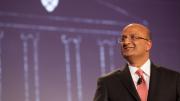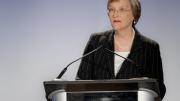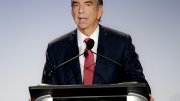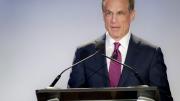In the transformed Shad gymnasium, Harvard Business School (HBS) dean Nitin Nohria formally launched its $1-billion capital campaign on Friday evening, April 25: a day that began as another in a series of cool, tardy spring mornings (when the exhortation on a campaign banner at the school— “Let’s begin”— could have applied equally well to the change in seasons), but obligingly warmed and brightened as the fundraising events reached their evening crescendo. The effort, Nohria said in a conversation a week earlier in his Morgan Hall office, “will secure HBS’s capacity to engage in bold, innovative experiments on a scale and scope that are meaningful.”
In fact, that modest tag line, “Let’s begin,” had dual meanings. It was, of course, an exhortation to campaign volunteers, staff members, and supporters. But it also succinctly captured Nohria’s focus on innovation as an overarching theme for HBS, and the size of the ambition he put before the school. In a remarkably personal, emotional campaign address, the dean recalled his father growing up in a village without electricity, learning to read by natural light—and rising to lead a large power company, whose mission was not only to profit but to light the lives of many people in India, and to help them prosper. That experience, Nohria said, drew him into business. During the twentieth century, he observed, a billion people joined the ranks of those benefiting from “economic inclusion.” By the middle of this century, the world population will be nine billion, so there will be “many more people waiting to be brought into this circle of economic inclusion.” That aspiration “cannot happen without business. So let’s begin.”
Emphasizing Innovation
The experiments to which Nohria referred, in the interview and his address, have come at a brisk pace in this new millennium:
- the network of global research offices launched by former dean Kim Clark, now extending to eight centers around the world, to support truly international teaching cases and content;
- the Harvard Innovation Lab, opened in late 2011 and now serving entrepreneurs University-wide;
- the flexible classrooms on the iLab’s upper floors—the physical infrastructure for the school’s new “visceral, team-based, action-oriented” pedagogy, as Nohria characterized the first-year FIELD curriculum (Field Immersion Experiences in Leadership Development) in an interview last year, describing the attempt to develop a set of learning experiences parallel to the traditional case-based, classroom pedagogy for which HBS is famous. (See this Harvard Magazine report on the FIELD course in action through student immersion in international businesses, and team-based entrepreneurship.) and
- HBX, the online-learning venture unveiled last month that extends HBS teaching to undergraduate and non-M.B.A. graduate students, broadens executive education outreach, and creates a Boston studio for worldwide executive-education teaching in real time.
With these and other initiatives growing beyond their beginning phases—and in many cases expanding rapidly beyond the scale at which they were initially envisioned—Nohria said last year, as the campaign plan took shape, that he aimed to “get the intellectual work of the school funded in a way it has never been funded before.” (Read a detailed description of the campaign priorities below.)
A capital campaign, Nohria said last week, “enables things that you don’t even know the full import of when you do them.” HBS, he pointed out, has in fact really conducted only three previous, formal fund drives.
- The first, in the 1920s, underwrote the Allston campus, in effect establishing the school’s identity as a separate entity with a distinctive, residential pedagogy.
- The second, in the late 1940s, created Aldrich Hall and other facilities fundamental to the student learning experience through the case method.
- The third (conducted publicly from 2002 to 2005, when it closed with $598 million in gifts; see “Capitalism Campaign,” November-December 2002, and “Bolstering Business,” May-June 2006) yielded significant physical enhancements: the Spangler Center (student services), Hawes Hall (classrooms), and the overhaul and expansion of Baker Library Bloomberg Center (the library and multiple new faculty offices). But most significantly, Nohria said, it transformed HBS’s financial-aid program and its ability to support a diverse, international student body accessible to M.B.A. and doctoral candidates worldwide. (HBS’s timing in that case was especially fortunate: it was the only Harvard unit, other than the Law School, to launch a campaign in the decade after the $2.6-billion University Campaign concluded in 1999—and its fundraising concluded before the financial crisis that began in 2008.)
The context for the current campaign is shaped, Nohria underscored, by the rapidity and magnitude of changes in business practice and education—demands that he characterized as unprecedented and less predictable than ever before. Online education, for instance, “came from nowhere,” he said. “It was not even on the horizon when I was named dean” less than four years ago. That puts a premium on rapid institutional growth, the capacity for imaginative change, and sufficient resources and flexibility to undertake significant investments where required—as in FIELD, the iLab, and HBX.
During events that preceded the kickoff speeches in late afternoon and early evening, the effects of these innovations were demonstrated. HBS faculty members staged classroom case discussions for visiting alumni and supporters, and faculty-student panels illustrated innovations in the first-year M.B.A. curriculum through FIELD units, in the second-year elective curriculum, and in the iLab. (All these sessions, formally considered classes, were closed, as is the school’s usual practice.) In the afternoon, faculty members and alumni joined in a series of panels focused on interdisciplinary research (a high campaign priority) into broad social challenges such as healthcare, public education, and energy policy, and such generally applicable HBS concerns and disciplines as social entrepreneurship, leadership, digital innovation, and the role of financial markets.
Each of those recent experiments was individually important, Nohria said, “but the meta is, do we secure for any dean in the future the capacity to be imaginative and innovative in this way?” A successful campaign, he said, would “greatly enlarge and enhance our confidence to be the leader in business education,” acknowledging that HBS will want to transform itself continually to fulfill its mission of educating “leaders who make a difference in the world” without knowing precisely what new capacities will be required to excel in the years ahead.
His confidence is surely underpinned by beginning the public phase of the new campaign successfully. Before Nohria spoke on April 25, campaign chair John B. Hess ’75, M.B.A. ’77, chief executive officer of the eponymous Hess Corporation, announced both the $1-billon goal and results from the quiet phase of fundraising: more than $600 million in support already committed: a sum exceeding the total proceeds of the drive that ended in 2005.
Five Priorities and Flexible Funding
The campaign seeks support in five categories (some overlapping). On the agenda are new interdisciplinary research, innovations in education, internationalization, and other focal points, all closely aligned with the dean’s five “I” priorities (innovation, intellectual ambition, internationalization, inclusion, and integration with the rest of the University).
• Intellectual ambition. Nohria described this $250-million priority as funding for major research initiatives extending beyond individual faculty members’ interests to address major topics such as healthcare, business and the environment, social enterprises, digital innovation, and competitiveness. (The initiatives are described here.) The U.S. Competitiveness Project, reported here, helped to model this kind of broad enterprise. A prospective initiative on gender, stemming from the school’s focus on the first half-century of enrolling women M.B.A. students, may also come under this umbrella. The dean said the resources garnered through the campaign would provide the intellectual infrastructure to carry out the research, and to distribute it—in part by replacing the school’s Burden Hall, a large auditorium (designed by Philip Johnson ’27, B.Arch. ’43) with a new, 140,000-square-foot multiuse conference center and related facilities, incorporated as part of the University’s current Allston construction plans. (In his address on April 25, Nohria said the gift needed to proceed on the new center had been received.)
The dean said that in support of the interdisciplinary initiatives, the school hoped to secure funds for a 5 percent to 10 percent expansion of the faculty, which numbered 227 full-time equivalents at the end of fiscal 2013. (The Allston plan envisions a 110,000-square-foot HBS faculty and administrative building later this decade.) One such incremental professorship was recently funded as a part of the enormous gift for undergraduate financial aid made by hedge-fund leader Kenneth C. Griffin ’89; his wife, Anne Dias Griffin, earned her M.B.A. at the school in 1997.
• Innovation in education programs. The initiatives expected to be underwritten with $200 million of campaign proceeds include the FIELD curriculum, HBX, and a significant investment in executive education. Nohria said FIELD was “very expensive to support.” According the letter of HBS chief financial officer Richard P. Melnick in the school’s 2013 annual report, the faculty, travel, and administrative costs for FIELD on campus and internationally have added $10 million to the annual expense of operating the M.B.A. program, only a “minor portion” of which are covered by tuition and fees. (Notwithstanding such costs, and others discussed below, HBS’s financial statements recorded a positive $45 million from operations before financing its capital projects; even adjusting for reporting in accordance with generally accepted accounting principles, the school would have shown an operating gain nearly that large.) Nohria said the growth of FIELD’s team-base entrepreneurship teaching and exercises may also require additional purpose-built teaching spaces.
HBX launched with a proprietary technology platform, a staff of nearly three dozen, and dedicated office space—and with plans to invest in studio facilities and more; campaign literature solicits gifts in the tens of millions of dollars to support the enterprise (which has a user-fee revenue model, in contrast to the free “massive open online courses,” or MOOCs, offered through HarvardX).
Executive education “has been the school’s top capital investment priority” of late, according to Melnick’s letter: the new Tata Hall residence was dedicated in December; on April 24, HBS broke ground on the Ruth Mulan Chu Chao Center, a replacement for Kresge Hall—a central executive-education dining and convening facility; a thorough renovation of the Baker Hall residence is also under way. Nohria noted that executive education, begun in the middle of the twentieth century, now serves 10,000 matriculants annually (an increase of more than 20 percent from fiscal year 2009 through 2013). That extends HBS’s educational reach and provides a major source of revenue to support other parts of the research and teaching enterprise ($146 million in fiscal 2013, up 27 percent from 2009, and fully one-quarter of total revenue in the latest year). When the construction concludes, the northeast corner of HBS’s campus will, in effect, be an executive-education quadrangle—a place, Nohria said, intended to be as welcoming and immersive for learners in residence for limited-term courses as the rest of the campus is for full-time M.B.A. candidates. (The aggregate investment is not trivial: although other projects are obviously included, too, Melnick’s letter reports that HBS capital spending was $78 million in fiscal 2013, up from $14 million in 2010—and the letter projects a further 56 percent expansion to $122 million of capital spending this academic year.)
• Internationalization. HBS exemplifies the University strategy of pursuing a broad, global “intellectual footprint” with a lean “physical footprint.” The field offices have undergone “mind-boggling growth” during the past decade and a half, Nohria said (there are now sites in Silicon Valley, Buenos Aires, Paris, Istanbul, Mumbai, Hong Kong, Shanghai, and Tokyo—including full-scale executive-education case-teaching classrooms in Shanghai and Mumbai). The model has been proven, he said: 60 percent of cases taught in the M.B.A. program are international to some extent, and international HBS alumni have been engaged by the research presence in their home countries. But even with relatively focused functions and small staffs, the offices themselves, and the case-writing they enable, are expensive: an international case, involving travel and translation, typically costs five times as much as a domestic one, the dean said.
Other international elements Nohria includes within this $150-million goal are the January experience abroad for first-year FIELD students; parts of executive education; better recruiting (job placement) for the many students who seek opportunities outside the United States; and disseminating content from Harvard Business Publishing (HBS’s largest revenue source) internationally (not just selling cases from the United States to other markets, but also, for instance, selling cases about Brazil to the People’s Republic of China, and vice versa—to mention two countries closely linked by enormous flows of trade).
• Inclusiveness. Further financial-aid resources, said Nohria, would enable HBS to fully endow M.B.A. and other fellowships, rather than draw on its unrestricted operating funds. Beyond that scholarship support, he talked about the school’s commitment to “enable people to pursue their passions without anxiety about the debt they may have or the income they may earn.” For example, HBS has experimented with social-enterprise fellowships during the past decade: for graduates who choose to work at such an enterprise, the employer pays half of the salary and the school matches those funds, to provide an income of $90,000. During summers, fellowship funds enable students to “try their hand,” he said, to experiment as entrepreneurs or to explore work in healthcare, life science, or a social enterprise (all less lucrative than the possibilities in investment banking or finance). The $150 million sought for aid will encompass all these priorities, and perhaps the emerging gender initiative.
• Integration. Here, Nohria outlined initiatives joining HBS to other parts of Harvard, totaling $100 million. A visible priority is funding the investment already made in the iLab, and preparing for its unforeseen growth (what he called iLab 2.0).
Within this category, he also aims for a flexible HBS One Harvard Fund for $50 million, to effect multiple objectives. It would help overcome the budgeting problems that arise when HBS faculty members teach elsewhere—necessitating some coverage of their business-class obligations—as they increasingly do (courses on entrepreneurship and on capitalism and democracy in the College, for instance, taught respectively by Heinz professor of management practice in environmental management Joseph B. Lassiter and McLean professor of business administration David A. Moss); that won’t solve every problem of scheduling teaching coverage, Nohria said, but “we could at least make economics not be the problem.” It would also enable joint appointments, like that being extended to Matthew Rabin, who is joining the new Faculty of Arts and Sciences-based foundations of human behavior initiative. The funds could also support University intellectual collaborations.
And, as a nascent idea, the dean said there could be a catalyst fund for emerging opportunities in Allston, as the School of Engineering and Applied Sciences (SEAS) establishes a major presence in new facilities across Western Avenue from the HBS campus. For instance, Nohria threw out the idea for a joint master’s degree, for which it would be propitious, and efficient, to have flexible funding in hand in advance. (In their recent report on the design of the Allston facilities, SEAS faculty members expressed enthusiasm for convening facilities like those that may be built when HBS replaces Burden Hall; obviously, both parties envision a future of rich collaborations.)
• Unrestricted funding. Finally, current-use, unrestricted gifts (projected at $150 million during the course of the campaign) will be aggregated as an HBS Fund for Leadership and Innovation.
The Talk
The formal kickoff event, in Shad, began with my HBS, a video of alumni recalling resonant HBS experiences, from their application for admission through their anxieties at being cold-called in class for the first time, through the lifelong friendships and networks they built from meeting fellow students in sections.
Faculty campaign chair Robert Steven Kaplan, M.B.A. ’83 (Marshall professor of management practice in business administration and one of two senior associate deans for external relations—double the usual complement, during the campaign), talked about taking a leave from Goldman Sachs, where he was vice chair, to teach a first-year HBS leadership course in 2006, and deciding to stay. He had come to see this “incredible place” from the inside, and appreciated as never before that faculty and staff members and administrators “embody and practice all the things we teach here.” He then introduced President Drew Faust.
Backed by a huge projection reading “One Harvard,” one of her themes for The Harvard Campaign, Faust reprised some of her September speech that launched the overall fundraising drive. She then said Harvard’s campaign was “about leadership”—at the center of HBS’s mission. Recounting the school’s history in pioneering M.B.A. education, the case method, corporate strategy, and such fundamental business concepts as the value chain and disruptive innovation, she then observed that pressing human problems of economic and political development and scientific discovery “all demand approaches and solutions” grounded in organization, management, and innovation. The University’s work now links schools in common inquiries and teaching, and the campaign’s goal of building a new home for SEAS in Allston was the first step in a process that would ultimately result in HBS—long by itself across the Charles River—finding itself at the center of campus. She hailed Nohria as a partner, and punningly referred to his priorities by saying of his deanship, “The I’s have it.” Much as HBS trains leaders to make a difference in the world, she concluded, “This is a campaign about making a difference.”
Campaign chair John Hess asked the audience, “What did you learn from your Harvard Business School experience?” He suggested that the likely answers—asking the right questions; turning vision into action; assuring that the “right people [are] in the right seats”; and doing the ethically right thing—resonated daily. In his own case, he said, those disciplines shaped his repositioning of the corporation his father had founded and built, reorienting it from an oil refining and marketing enterprise into one focused today on energy exploration and production.
(Hess has spoken and written at HBS about energy policy, the need for increased efficiency, and the possible use of taxes to reduce consumption of carbon-based fuels. His company’s transition has been the subject of an HBS case study about investor interest in simplifying its business. But most people probably know it through the Christmas Hess truck toys sold through its formerly owned gas stations. And—who knew?—they are a subject of interfaculty interest: in a recent blog post, Faculty of Arts and Sciences dean Michael D. Smith confessed his boyhood affection for the Hess vehicles, the source of the collection that now decorates his office in University Hall. One Harvard, anyone?)
At a time when public budgets are strained and political processes are gridlocked, Hess said, the public has also lost trust in business. It behooves business leaders to remind the public that business is a force for good, fundamental to society—and that as HBS graduates know acutely, “good leadership” has a “multiplier effect.” To sustain that crucial leadership training, he said he was honored to be asked to chair the HBS campaign, whose goal and success to date he then disclosed.
Dean Nohria thanked Hess, Faust, and the campaign staff and leaders. He spoke about being “full of love for this institution,” an infatuation that began in September 1984, on the morning when he enrolled as a scholarship student at MIT and then walked up Memorial Drive, came to the bend in the Charles, was struck by the sight of HBS, crossed the foot bridge, and spent the rest of the day wandering around the campus. Had the technology then enabled it, he said, “I would have been taking selfies the entire day.”
He recounted the school’s history through the momentous choices that shaped it—including the choice to build the campus that so enraptured him when the opportunity arose in the mid 1920s. From the early commitment to research, through the World War II 12-week training program that led to executive education, to doctoral education in business, the publishing operation (Harvard Business Review, cases, books, and now digital services), and the research centers that gave HBS “the most global intellectual footprint in the world,” the school, he said, had been enabled to lead in business education.
“What we will add to this secret sauce?” he asked. “How will we make Harvard Business School better?” He laid out the recent investments in executive-education facilities, and campaign plans to enhance financial aid and faculty research ambitions. And then he connected all the discrete plans to the overarching themes of equipping the school with “the courage and the capacity to be innovative—not just now, but for the future.” Citing the FIELD course, iLab, and HBX, he cited the capacity to “turn on a dime,” to “get things done,” as needs arose.
The educational result, he said, echoing Faust’s comments on leadership, was a cohort of leaders in any field of human endeavor, from business to healthcare, education, and beyond, all grounded in the school’s bedrock commitment to education in “general management.” Those management leaders, he said, are “creating economic opportunity all across the world,” the only path toward sustainable prosperity.
A spectacular video, The Case for the Future, then illustrated Nohria’s points about HBS leaders in diverse realms around the planet, featuring alumni including Mark Fields, M.B.A. ’89 (who in a bit of lucky campaign timing was publicly identified a few days earlier as the likely next CEO of Ford Motor Company); Kathryn Giusti, M.B.A. ’85, founder and CEO of the Multiple Myeloma Research Foundation (she was diagnosed with the disease in 1998); Ndidi Nwuneli, M.B.A. ’99, and Udemezuo Nwuneli, M.B.A. ’03, co-founders of AACE Food Processing & Distribution, an indigenous foods and agriculture company based in Nigeria; and Mark Tercek, M.B.A. ’84, a former Goldman Sachs partner who became CEO of The Nature Conservancy in 2008.
Nohria then closed the sale. “So, let’s begin,” he told the crowd, “to prepare the next generation of leaders who can succeed in this ever more complex world.” The people depicted in the film, he said, demonstrate that “a great leader can create extraordinary value.” He would argue, he said, that “leadership can make all the difference, so let’s begin.” He raised the stakes to a world scale (those nine billion people by 2050, eager to gain access to the circle of economic inclusion), and challenged the campaigners to exceed their goal: “Let’s begin.”
The HBS Campaign in University Context
With the business-school goal now public, nearly $4.1 billion of the $6.5-billion aggregate goal for The Harvard Campaign has been spoken for: Faculty of Arts and Sciences ($2.5 billion, including SEAS); Harvard School of Public Health ($450 million); Radcliffe Institute ($70 million); Harvard Divinity School ($50 million); and HBS ($1 billion). Assuming as a back-of-the-envelope calculation that Harvard Medical School, heavily dependent on external research funding (which is now flat at best), sets an HBS-sized goal; and that the Kennedy School, Graduate School of Education, Law School, and space-starved Graduate School of Design in the aggregate seek at least another billion dollars when they announce their campaigns later this spring and next fall—then the central, University-wide priorities are budgeted at less than $500 million. Some of those priorities are expensive: the edX online learning venture, the Harvard Initiative for Learning and Teaching, “common spaces” such as the Smith Campus Center, and—most of all—the multihundred-million-dollar SEAS building in Allston (which is a University commitment, beyond the FAS campaign). This may suggest some flexible view of the $6.5-billion aggregate fundraising goal (which campaign leaders pledged to exceed during the launch event last September), or a willingness and ability to use debt financing for at least a significant part of some of the hoped-for major capital projects.












